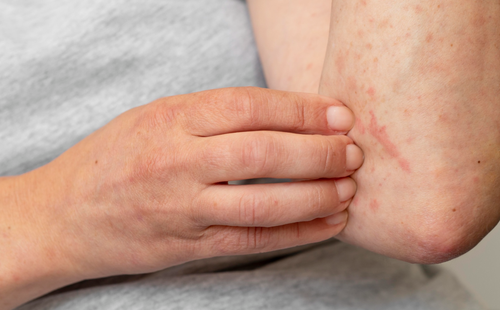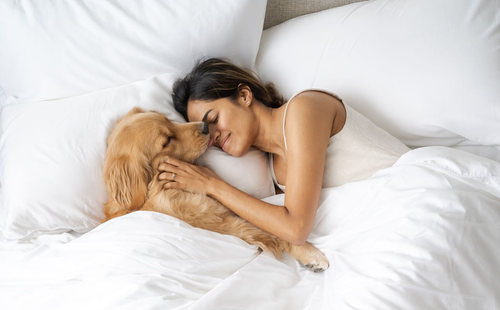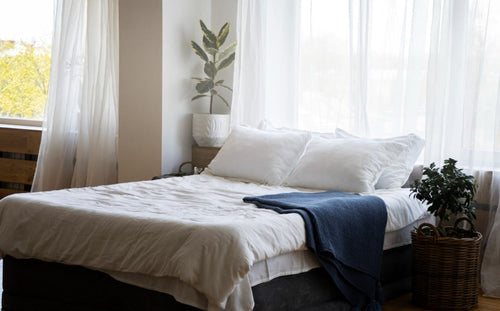At a glance
From allergens and detergent residue to fabric chemicals, this guide explains the hidden culprits and simple changes that can calm your skin for good.
Quick tips
- Wash new sheets twice before use to remove surface chemicals.
- Choose hypoallergenic, OEKO-TEX® certified fabrics like TENCEL™ or cotton.
- Wash bedding weekly with gentle, fragrance-free detergent.
Yes, bed sheet hives are real, and they're more common than most people think. Between dust mites, detergents, rough fabrics, and even heat build-up, your bed can absolutely trigger an allergic reaction or irritation that shows up as raised, itchy welts on your skin.
This article breaks down what's actually going on, how bedsheets can cause hives, and what to change in your bedding routine, especially if you're in humid Singapore, to calm your skin down without guessing.
Common Causes of Hives from Bed Sheets
Allergens in Bedding
Your mattress and bed sheets can quietly collect allergens over time. A U.S. study found that about two-thirds of beds contained dust-mite levels high enough to trigger allergies. These tiny creatures love humid places like Singapore and feed on dead skin cells found in mattresses, pillows, and bedding.
If you often wake up sneezing, with a stuffy nose, watery eyes, or itchy skin, you might actually be allergic to bed sheets, or more precisely, to the dust mites and allergens trapped in them. In some cases, this can even lead to red, itchy rashes or hives.

Image By Krakenimages.com From Freepik
Detergent & Fabric Softener Residue
A dermatology report analysing 17 common household detergents found that all 30 volunteers experienced some form of skin irritation during testing. In simple terms, some detergents caused noticeable redness and dryness, while others caused only mild reactions.
The study explains that detergents can weaken the skin’s protective barrier, making it easier for irritants to get in, which is why certain products feel much harsher on sensitive skin.
If your symptoms began after switching detergents or softeners, the reaction may come from leftover residue rather than the fabric itself. Heavy softeners can cling to pillowcases and fitted sheets, especially in humid weather, and worsen irritation.
Irritating Fabrics & Chemical Finishes
Sometimes, the problem lies in the fabric or its finishing process. Contact dermatitis often occurs from exposure to formaldehyde resins, dyes, or other chemicals added to make fabrics wrinkle-resistant.
These substances don’t affect everyone, but they can cause redness or itchy rashes in people with sensitive skin or eczema. If you’ve ever noticed a rash from bed sheets, it may be due to these chemical finishes or synthetic fibres irritating the skin.
Rough synthetic blends also trap heat and moisture, which can worsen irritation. In contrast, high-quality fibres like TENCEL™ Lyocell or 100% cotton bedsheets allow airflow and wick away moisture, keeping the skin cool and comfortable.
That’s why it’s important to look for bed sheets that are OEKO-TEX® certified, ensuring they’re free from harmful chemical residues.
Featuring Weavve’s King Bed Sheets
Heat, Sweat, And Friction Build-Up
Hot, humid nights in Singapore are the perfect breeding ground for irritation. When your sheets don't breathe, the accumulated sweat generates a warm, damp microclimate that fuels both itching and dust mite activity.
Chemical Treatments
New sheets may come already treated with dyes, anti-wrinkle coating, or preservatives in their packaging. Wearing them right out of the box may expose your skin to these chemicals, causing rashes from bedsheets or hives.
Unwashed fabrics are among the most common sources of textile-related allergic reactions. Washing new bedding once or twice before you use it for the first time gets rid of chemicals on the surface and lowers the chance of irritation.

Image By Rawpixel.com From Freepik
How to Prevent Hives From Bed Sheets
Opt for Hypoallergenic Bed Sheets
What makes a sheet hypoallergenic? In general, hypoallergenic sheets are made from materials that resist allergens and are processed without harsh or irritating chemicals.
People often choose materials like cotton, bamboo blends, or TENCEL™ bed sheets in Singapore because they allow better airflow and are gentle on the skin.
In Singapore’s warm and humid climate, using bedding that stays cool and dry helps prevent sweat buildup, trapped heat, and dust-mite growth, all of which can trigger skin irritation or allergies.
Signature TENCEL™ Bedsheets are known for their silky-smooth texture that feels gentle even on sensitive skin. The fibres are naturally hypoallergenic and moisture-wicking, helping to keep you cool and dry throughout the night.
For those who prefer the classic feel of cotton, Weavve’s Cotton Bedsheets offer breathable comfort and lasting durability.
Featuring Weavve’s Cotton Classic Set
They are OEKO-TEX® certified, meaning every component is tested and verified free from harmful substances. The crisp, smooth weave helps maintain airflow, making them a reliable choice for sensitive sleepers.
Use a Mattress Protector
Weavve’s Waterproof Mattress Protector safeguards your mattress from spills, bedwetting, and sweat, which are common causes of trapped moisture and allergen build-up. The outer layer is made from 100% TENCEL™ fabric, known for its smooth, breathable texture and natural cooling effect.
TENCEL™ fibres are gentle on the skin and excellent at wicking away moisture. They help reduce humidity, making it harder for dust mites and bacteria to thrive. This helps prevent common triggers of hives or allergic reactions.
Featuring Weavve’s Mattress Protector
A mattress protector also limits direct contact between your skin and potential irritants trapped in bed sheets, keeping your sleep surface cleaner and more hygienic. Together with hypoallergenic bed sheets, it forms an extra layer of protection for an irritation-free night’s rest.
Wash Sheets Regularly
Regular washing of bedsheets, duvet covers, and pillowcases is essential for cleaning away accumulated sweat, oils, dust mites, and allergens. Most allergen-prevention guidelines recommend washing bedding once a week for allergy-prone individuals.
Wash in hot water when the fabric allows it, and dry the laundry completely. Skipping this encourages a rash from dirty sheets.
Use Gentle Laundry Products
Use fragrance-free, dye-free, hypoallergenic detergents and avoid heavy fabric softeners to reduce the risk of skin irritation caused by detergent residue.
Allergic reactions to detergents are rare, but irritation from residue or harsh chemicals is much more common, especially for those with sensitive skin.
If you suspect your detergent is the cause, try an elimination test by switching to a gentle detergent for three weeks to see if symptoms improve.

Image From Freepik
Maintain a Clean Sleep Space
Your bed sheets play a big role, but your entire sleep environment matters too. Keep allergens away by regularly cleaning your mattress, vacuuming or replacing carpets, and washing bedding frequently. Removing dust-collecting items such as stuffed toys or decorative pillows can also help create a cleaner, healthier space for rest.
When to Seek Medical Advice
If you notice hives after lying on your bed sheets, they’re often mild and fade on their own. However, seek immediate medical help if you experience swelling of the face, lips, or tongue; shortness of breath; dizziness; or tightness in the chest, as these may indicate a severe allergic reaction.
It’s best to consult a dermatologist or allergist if your hives keep coming back, last longer than 24 to 48 hours, spread across the body, or show signs of infection, such as oozing or pain.
Persistent irritation despite using hypoallergenic bedding and gentle detergents could point to a deeper cause, such as contact dermatitis, a fabric allergy, or another skin sensitivity. A professional can help identify the trigger and guide you toward the right treatment for long-term comfort and relief.

Image By Tirachardz From Freepik
Frequently Asked Questions
Why am I breaking out in hives in bed?
There could be several reasons for this: lying on sweaty, hot sheets; a high allergen load in your mattress and pillows; a contact allergy to fabrics or detergents; or irritation due to friction if the material is rough. Knowing which one of these factors applies to you will help you determine what to change.
How do I know if I'm allergic to my bed sheets?
Consider if your reactions are limited to when in bed and if symptoms improve by sleeping elsewhere or changing sheets/detergents. A dermatologist's patch test might identify allergens in fabrics or detergents. Accompanying symptoms like a stuffy nose or itchy eyes in bed may suggest an allergy.
Why are my sheets breaking me out?
If your sheets are coarse, synthetic, treated with chemicals, or non-breathable, in which case you sweat inside the sheets, they will irritate your skin. Also, if your sheets aren't being washed often enough, the accumulated oils, skin flakes, and allergens can clog pores and provoke bumps or hives.
We recommend choosing hypoallergenic bedsheets in Singapore or bedsheets for sensitive skin made from breathable natural materials, such as TENCEL™ Lyocell or cotton. These fabrics are gentle on sensitive skin, help regulate temperature, and reduce the chance of irritation while you sleep.
What is the 3-minute rule for eczema?
It means applying moisturiser within about three minutes after showering or bathing, while your skin is still slightly damp, to lock in moisture and help protect the skin barrier. This reduces flare-ups in people prone to eczema, which can otherwise make skin more reactive to bedding.
Why do I get itchy every time I lay in my bed?
Feeling itchy when you lie down could be a sign of allergens or irritants in your sleep environment. Dust mites, detergent residue, or rough synthetic fabrics can trigger mild allergic reactions or skin irritation. If your sheets aren’t washed often enough, the build-up of sweat, oils, and skin flakes can also make the problem worse.
What are the first signs of bed bugs on sheets?
The first signs of bed bugs often appear directly on your sheets or mattress. You may notice small rust-coloured or dark spots, which are droppings or crushed bugs, along with tiny blood stains from bites. Sometimes, you might also see shed skins or small white eggs near the seams of your bedding or mattress.
Unlike dust mites, bed bugs bite and leave itchy, red marks on exposed skin areas such as arms, legs, or the back. If you suspect bed bugs, wash your bedding in hot water and inspect your mattress closely. Persistent bites or visible signs should be addressed with a professional pest inspection.
Can dirty sheets cause bumps on skin?
Yes, when sheets aren't washed, sweat, oils, and dead skin cells that are linked to allergies can block pores, irritate, and cause little bumps. If bedding is left unwashed for an extended period of time, it may eventually result in rashes, hives, or other contact responses.
Premium Skin-Friendly Bed Sheets in Singapore
No more wondering if bed sheets can cause hives; the answer is yes. The good news is that relief often starts with something simple: upgrading your bedding and creating a cleaner, more skin-friendly sleep environment.
For those looking for bed sheets in Singapore, our Signature TENCEL™ Collection and Cotton Bedsheets are thoughtfully designed to care for sensitive skin and support restful, irritation-free sleep.
-
TENCEL™ bed sheets offer a luxuriously silky touch and naturally cooling comfort. Made from sustainably sourced fibres, they are hypoallergenic, breathable.
“The material is super soft, and it’s definitely a good investment to get this set! I do have sensitive skin, and it doesn’t itch or irritate me at night.”
-
Cotton bed sheets deliver that classic crisp feel - soft, durable, and wonderfully airy for year-round comfort.
“Weavve cotton sheets are great! Love the good feel on the skin and it's easy maintenance after wash."
Loved by sensitive sleepers, our bed sheets combine quality craftsmanship with skin-safe materials, giving you the comfort and peace of mind you deserve every night.













































